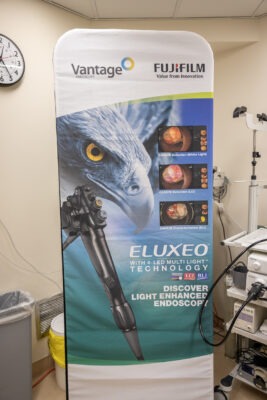
Better equipment, better care. New endoscopes at four HHS sites
 Hamilton Health Sciences (HHS) recently unveiled state-of-the-art endoscopy equipment, enhancing patient care and bolstering diagnostic capabilities. With a focus on advanced technology, ergonomic design, and improved imaging, this new equipment marks a significant milestone in gastrointestinal health care delivery at HHS.
Hamilton Health Sciences (HHS) recently unveiled state-of-the-art endoscopy equipment, enhancing patient care and bolstering diagnostic capabilities. With a focus on advanced technology, ergonomic design, and improved imaging, this new equipment marks a significant milestone in gastrointestinal health care delivery at HHS.
“It’s a game-changer for the hospital. Now our patients can get both their diagnosis and treatments at HHS.”
Tracey Corner, perioperative clinical manager, played a pivotal role in the procurement process to lease the new endoscope system from Vantage. She says the introduction of this cutting-edge equipment signifies a leap forward in patient care.
“This new equipment allows us to perform advanced procedures in-house, reducing the need for patients to visit other facilities,” Corner explains. “It’s a game-changer for the hospital. Now our patients can get both their diagnosis and treatments at HHS.”
Dr. Frances Tse, gastroenterologist, echoes this sentiment, emphasizing the benefits for both patients and medical teams. “The enhanced image quality provided by this equipment is crucial for detecting polyps and lowering the risk of colon cancer,” says Dr. Tse. “As well, the ergonomic design minimizes fatigue for doctors, improving overall procedural outcomes.”
New high-def images
The new equipment boasts several key features, including high-definition imaging, AI technology for polyp detection and characterization, and deep balloon enteroscopy for comprehensive small bowel examination.
One notable feature is its improved scope navigation system, likened to a GPS system. This 3-D navigation tool enhances precision, reduces patient discomfort, and allows for better identification and navigation of anatomical structures.
With more than 18,000 procedures conducted annually across four sites, the impact of this equipment on patient care is substantial.

The new equipment fits more easily in patient rooms when needed at the bedside.
Corner emphasizes the equipment’s versatility. “This equipment caters to a wide range of procedures, from gastroenterology to respirology,” she says. “The system can be used for both adults and children as well.”
The equipment’s smaller size and lightweight design offer practical advantages for medical teams. Travel carts equipped with the new endoscopy equipment are easier to maneuver, reducing strain on staff and fitting in a patient’s room much better when required at the bedside.
Substantial impact on patient care and research opportunities
With more than 18,000 procedures conducted annually across four HHS sites including McMaster University Medical Centre, Juravinski Hospital and Cancer Centre, Hamilton General Hospital and West Lincoln Memorial Hospital, the impact of this equipment on patient care is substantial.
Looking ahead, HHS aims to leverage this technology for research opportunities and continued advancements in patient care.
“The introduction of this equipment opens up avenues for research and innovation in gastrointestinal health care,” says Tse. “We are excited about the possibilities it presents for improving patient outcomes.”
The new endoscopy equipment at Hamilton Health Sciences represents a significant advancement in patient care, offering enhanced diagnostic capabilities and improved procedural outcomes. With its state-of-the-art technology and ergonomic design, this equipment sets a new standard for gastrointestinal health care delivery.
Colon cancer awareness month
March is colon cancer awareness month. For people who are at average risk, with no signs or symptoms of colon cancer and without a close relative who has been diagnosed with colon cancer, talk to your health care provider about getting an at-home test.
For people with above-average risk, talk to your health care provider about getting checked with a colonoscopy. They may refer you to HHS for your procedure.
OHIP pays for both at-home tests and colonoscopies.






